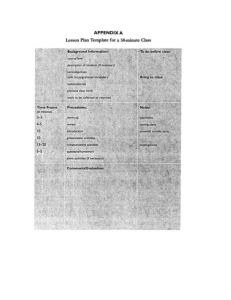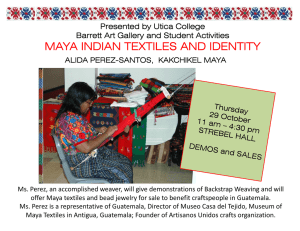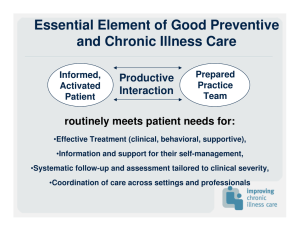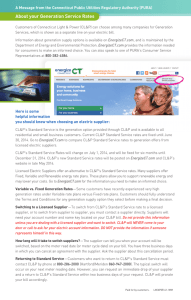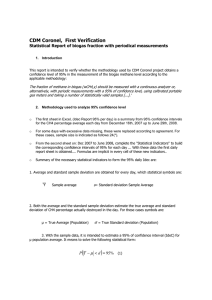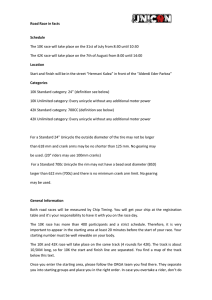mayan mathematics and standards for elementary school in
Anuncio
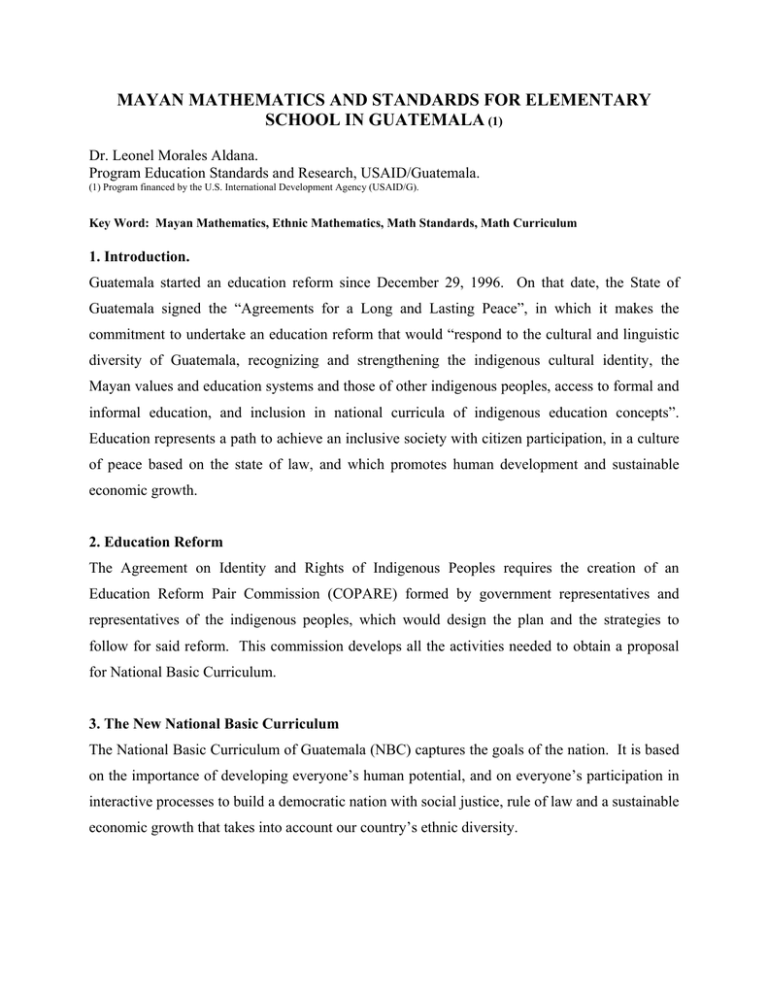
MAYAN MATHEMATICS AND STANDARDS FOR ELEMENTARY SCHOOL IN GUATEMALA (1) Dr. Leonel Morales Aldana. Program Education Standards and Research, USAID/Guatemala. (1) Program financed by the U.S. International Development Agency (USAID/G). Key Word: Mayan Mathematics, Ethnic Mathematics, Math Standards, Math Curriculum 1. Introduction. Guatemala started an education reform since December 29, 1996. On that date, the State of Guatemala signed the “Agreements for a Long and Lasting Peace”, in which it makes the commitment to undertake an education reform that would “respond to the cultural and linguistic diversity of Guatemala, recognizing and strengthening the indigenous cultural identity, the Mayan values and education systems and those of other indigenous peoples, access to formal and informal education, and inclusion in national curricula of indigenous education concepts”. Education represents a path to achieve an inclusive society with citizen participation, in a culture of peace based on the state of law, and which promotes human development and sustainable economic growth. 2. Education Reform The Agreement on Identity and Rights of Indigenous Peoples requires the creation of an Education Reform Pair Commission (COPARE) formed by government representatives and representatives of the indigenous peoples, which would design the plan and the strategies to follow for said reform. This commission develops all the activities needed to obtain a proposal for National Basic Curriculum. 3. The New National Basic Curriculum The National Basic Curriculum of Guatemala (NBC) captures the goals of the nation. It is based on the importance of developing everyone’s human potential, and on everyone’s participation in interactive processes to build a democratic nation with social justice, rule of law and a sustainable economic growth that takes into account our country’s ethnic diversity. Following the guidelines of the Design of the Reform and the General Framework for Curriculum Transformation, the NBC establishes several principles that mark its direction: equity, pertinence, sustainability, participation, and social commitment and pluralism. Of these, the most significant might be equity, pertinence and participation, given their importance in the creation of an integral nation. Pertinence includes the aspects seen in every ethnic-cultural expression of Guatemala’s peoples. Equity guarantees that the participation will be more extensive and more significant. The NBC is a curriculum that is based on competencies. It is focused on the competencies that can train a citizen who will be prepared to have a good life based on values and that can integrate into the country’s economic life in a positive way. The Curriculum places the student at the center of the learning process, and proposes that the student participate in the construction of his or her reality. 4. STANDARDS The content standards become references for the national evaluations. With them it is possible to develop criteria to guide standards tests at the national level, to monitor the development of education quality and to modify the system depending on the needs, in order to achieve the best possible education. With support from the Program of Education Standards and Research of USAID, the Ministry began a process to develop education standards for the period of 6 years old to preschool and for grades 1-6 of elementary school in five main areas: Communications and Language-1 (mother tongue), Communications and Language-2 (second language), Mathematics and Social and Natural Means (it becomes Social Sciences and Natural Sciences and Technology in the second cycle, i.e., 4th-6th grades). The standards for each grade set reference criteria for the performance evaluations of the students. The standards intend to establish clear statements of the minimum knowledge that the students must have in each grade, summarizing the declarative and procedural contents established in the National Curriculum for each area in each grade level. Hence, the minimum goals to be achieved are established and a minimum level of quality is ascertained. This is the only way to guarantee that education is being given in an equitable way across the country and to evaluate the academic performance of each region, each department and each community. 2 4.1 The process to build standards in Guatemala. One of the first actions to develop the education standards was the construction of a preliminary list of standards of content, based on the National Basic Curriculum (NBC). Groups were formed to develop said lists, with the participation of technical experts from the Ministry of Education, teachers in service and experts in the area. Afterwards a national consultation process was undertaken, with the participation of teachers, parents, students, authorities and institutions linked to education in Guatemala. Cabinetwork was undertaken to reach a proposal. Said proposal was analyzed in the National Encounter for Education Standards, which gathered together national experts, specialists on standards at the international level, teachers, students, parents, authorities and representatives of institutions related to education. Afterwards, area specialists were hired to review the preliminary lists, the results of the consultations, to produce another list that was agreed upon with technical authorities and officials of the Ministry of Education and then presented to the teachers, students and parents. Remarks and proposals were analyzed and a final version was produced. 4.2 Standards in Mathematics Given the multi-cultural, multi-lingual and multi-ethnic nature of our country and given the richness of the mathematics developed by the Mayas in Pre-Columbine times, special attention was given to the inclusion of cultural pertinence matters. This includes algorithms, measurement and geometry systems used by the Mayan peoples and other knowledge presently used by the peoples of Mayan descent. I will try to give some examples of Mayan mathematics and primary school standards, dividing them by components and sub-components of the NBC. I recommend that you visit the website of the Mariano Gálvez University in Guatemala, www.umg.edu.gt where you can access freely the course on Mayan Mathematics. This course includes most of the topics that appear in the standards and the NBC. Following are some examples. 4.3 Patterns and Relations In all Mayan languages spoken in the country, the names of the numbers are based on twenty, which makes it necessary for the primary school to develop both numeric systems: decimal and vigesimal. Written numbers have different representations, bars and dots, representations 3 through heads, representations of the whole body. Let’s see an example: all these heads represent the number four. These heads represent the number ten. Now let’s see something interesting, these other heads represent the number fourteen. When you analyze the different designs, can you find any relation between numbers 14, 10 and 4? One of the mathematic standards is the recognition of patterns and this is a good exercise of patterns. Number fourteen is formed with the jaw of number 10 and the crest and the eyes of number 4. Besides the dots and bars, the spelling and the name of the numbers, we have to work on their different representations. 4.4 Systems of Measurement Undoubtedly a society that built cities, buildings, temples and palaces of the magnitude that has been discovered in present times, must have used an exact measurement system, which was well known to most craftsmen. The standards propose measurements of length, surface, commercial measures and in particular measures of time, especially through calendars. The Cholq´ij calendar, which has 260 days; The Ab or agricultural calendar, which has 365 days; and the Long Account of Times, which measures time from the day in which the Mayan world was created: all 4 these are time measurements that are used in the different communities of the country, which makes it necessary for the children to learn about Mayan calendars as well as the Gregorian calendar. 4.5 MAYAN NUMERATION SYSTEMS The Mayan numeration system uses 3 symbols, the dot “•”, the bar “___” and for the zero, which represents a closed fist or a shell. With the combination of the dot and the bar the first 19 numbers are built. Number one is represented by a dot, and we combine 2, 3, and 4 dots, which represent numbers 2, 3, and 4 respectively. The bar represents number 5, and the other numbers are built with combinations of bars and dots. One, two, even three bars are used, combining them with one, two, three or even four dots. There are three rules to write numbers: R1. We combine the dots, from 1 to 4 dots. R2. Five dots form a bar. R3. We combine the bars, from 1 to 3 bars. The number 20 is a very important number, as are numbers 5 and 4. The 5 because it forms a unit, the hand; even today at the market, vegetables and fruits are purchased by HAND. Number 4 is important because 4 units of 5 form the person, a person has in total 20 fingers, and this also shows the importance of the number 20. In THE BOOK OF BOOKS OF THE CHILAM BALAM, translated by Alfredo Barrera Vázquez and Silvia Redón, we find, although translated into Spanish, the form to name some of the numbers: “twenty years plus fourteen” (P. 40). Graphically we have: 5 Numbers could also be written horizontally, from left to right, the bars placed horizontally and the dots placed to the left of the bar. Let’s see another example from the Chilam Balam: “four times twenty years and ten more” (P. 39) The purpose is to translate the contents described on the standards into what is taught in the schools across the country, to rescue the knowledge of the Mayan Mathematics. 6. CONCLUSIONS a) The knowledge of these algorithms may help to the self-esteem of the students. b) The study of the religious calendar could be a motivation for the students to expand their research on the topic of Mayan Mathematics and Western Mathematics. BIBLIOGRAPHY • Acuerdos de Paz. Gobierno de Guatemala, 1996. • CALEPINO EN LENGUA CACHIQUEL, De Fray Francisco de Verea. Edición original y actualizada, editada por Judy Garland de Butler, Publicado por Universidad Mariano Gálvez de Guatemala, 1997, Guatemala. Códice de Dresde, KUMATZIM WUJ JUN, Editorial Cholsamaj, Guatemala, 1998. • • • de León V., Carlos y F. López P., “POPOL VUH, Libro Nacional de Guatemala”, Guatemala, CENALTEX ministerio de Educación, 1985. Diseño de la Reforma Educativa, Comisión Paritaria de Reforma Educativa, Guatemala, 1998. • • • • • • EL LIBRO DE LOS LIBROS DE CHILAM BALAM, Traducción: Alfredo Barrera Vásquez y Silvia Rendón, Fondo de Cultura Económica. ENTREVISTAS, Documento de Trabajo de la Consultoría de Etnomatemática, de la Dirección de Educación Bilingüe Intercultural, Ministerio de Educación, Guatemala, 2000. Erich Von Daniken, “EL DÍA QUE LLEGARON LOS DIOSES”, Editorial Diana, México, 1986. Freidel, David, Linda Schele & Joy Parker, EL COSMOS MAYA, tres mil años por la senda de los chomanes, Fondo de Cultura Económica, México, 1999. Grube, Nikolai, “CURSO DE EPIGRAFÍA, traducción del Códice de Dresden”, OKMA, Antigua Guatemala, 2000. Ifrah, Georges, “OS NUMEROS A HISTORIA DE UMA GRANDE INVENCAO”, S. Paulo, Editora Globo, 1985. 6 • • Landa, Diego de, “RELACIÓN DE LAS COSAS DE YUCATÁN”, 7ª. Edición, Editorial Pedro Robredo, México, 1938. Lara-Alecio, Rafael, Beverly J. Irby & Leonel Morales Aldana, A MATHEMATICS LESSON FROM THE MAYAN CIVILIZATION, in Teaching Children Mathematics, Vol. 5, number 3, Nov. 1998. • León-Portilla, Miguel, “TIME AND REALITY IN THE THOUGHT OG THE MAYA”, Second Edition, University of Oklahoma Press, Norman, 1988. • Ministerio de Educación y Ciencia, 2005,PISA 2003, Pruebas de Matemáticas y de Solución de Problemas, Madrid. • Ministerio de Educación y Ciencia, 2000,PISA La medida de los conocimientos y destrezas de los alumnos. Un nuevo marco para la evaluación, Madrid. • Ministerio de Educación, 2005, Curriculum Nacional Base, Guatemala. • • Milbrath, Susan, star gods of the maya astronomy in art, folklore, and calendars, Universsity of Texas Press, Austin, 1999. Morales Aldana, Leonel, 1994, MATEMATICA MAYA, Ed. Gran Aventura, Guatemala. • Morley, Sylvanus G., “LA CIVILIZACION MAYA”, Fondo de Cultura Económica, México, 1968 • National Council of Teachers of Mathematics, 2005,Principles and Standards for School Mathematics, USA. • National Council of Teachers of Mathematics, 1991,Curriculum and evaluation Standarda for School Mathematics, USA. • • • • Prado Cobos, Antonio, “EL CREADOR MAYA”, Editorial Galería Guatemala, 1999. POPOL VUH, Libro Universal de la Renovación del Tiempo, Traducción: Carlos Rolando de León Valdes y Francisco López Peren, Editorial CENALTEX, Ministerio de Educación, Guatemala, 1985. Thompson, J. Eric S., MAYA HIEROGLYPHIC WRITING, Publication 589, CARNEGIE INSTITUTION OF WASHINGTON, Washington, 1950 Von Hagen, Victor W., “EL MUNDO DE LOS MAYAS”, primera Edición, 1964. ANEXO ESTÁNDARES DE MATEMÁTICA. 7 Componentes Pre-primaria Primer grado MATEMÁTICAS Segundo grado Tercer grado Cuarto grado Quinto grado Sexto grado Álgebra Geometría Estándar 1 Se ubica y orienta en su medio familiar y escolar. Estándar 1 Estándar 1 Estándar 1 Estándar 1 Estándar 1 Estándar 1 Identifica orden, posición y tiempo entre personas y objetos. Reproduce y crea figuras utilizando patrones de: tamaño, forma, posición y tiempo. Representa el movimiento de objetos y personas utilizando diferentes sistemas. Reproduce patrones y figuras con patrones, relacionados con su entorno natural y cultural. Construye y crea patrones y figuras con patrones, relacionados con su entorno natural y cultural. Rota, traslada y aplica simetría a patrones y modifica y crea series numéricas. Estándar 2 Estándar 2 Estándar 2 Estándar 2 Estándar 2 Estándar 2 Estándar 2 Dibuja líneas y formas, siguiendo trazos. Identifica características y propiedades cuerpos geométricos en objetos del entorno natural y social. Identifica y construye cuerpos geométricos usando elementos de su entorno familiar y escolar. Construye cuerpos geométricos, clasificándolos de acuerdo a sus propiedades y características. Identifica y construye elementos geométricos, y utiliza sus propiedades en la aplicación de rotación, traslación y simetría. Aplica rotación, traslación y simetría a diferentes cuerpos geométricos. Estándar 3 Utiliza unidades de moneda y tiempo en situaciones cotidianas. Estándar 3 Identifica: las unidades para longitud, volumen y peso en las medidas tradicionales, Sistema Inglés y Sistema Métrico Decimal; las diferentes monedas; las unidades de tiempo y calendarios gregoriano y maya Cholq´ij. Estándar 3 Utiliza: las unidades para longitud, volumen y peso en las medidas tradicionales, Sistema Inglés y Sistema Métrico Decimal; las diferentes monedas; y las unidades de tiempo en situaciones de su entorno natural y cultural. Estándar 3 Realiza mediciones de longitud, peso, volumen, moneda y de períodos de tiempo con base en calendario gregoriano y maya Cholq´ij en situaciones de su entorno natural y cultural. Aplica propiedades de ángulos, rectas, planos, polígonos y sólidos en la resolución de problemas geométricos. Estándar 3 Aplica equivalencias, dentro de cada sistema, para medidas de moneda, temperatura, longitud, superficie, volumen, peso, tiempo y calendarios gregoriano, maya Cholq´ij y maya Ab´ o solar, en situaciones de su entorno natural y cultural. Estándar 3 Utiliza múltiplos y submúltiplos dentro de cada sistema para medidas de longitud, superficie, volumen, peso, moneda, temperatura, tiempo, calendarios gregoriano, maya Ab´ y la cuenta larga, en situaciones de su entorno natural y cultural. Estándar 3 Calcula equivalencias entre sistemas de medida para: longitud, superficie, volumen, peso, temperatura, moneda, tiempo, calendarios gregoriano, maya Ab´ o solar y cuenta larga, señalando la precisión de los resultados de las mediciones. Estándar 4 Clasifica elementos de su entorno natural, social y cultural. Estándar 4 Clasifica y relaciona conjuntos dentro de su entorno social. Estándar 4 Utiliza y relaciona propiedades de elementos, conjuntos y subconjuntos para la solución de problemas presentes en su entorno social. Estándar 4 Realiza operaciones de unión e intersección entre conjuntos y subconjuntos en su entorno social. Estándar 4 Realiza operaciones de: diferencia de conjuntos, familia de un conjunto, producto cartesiano y relaciones binarias aplicándolos a situaciones de su entorno social y cultural. Estándar 4 Aplica diferencia simétrica, producto cartesiano, relaciones binarias y funciones en la resolución de problemas. Conjuntos Matemática, ciencia y tecnología Medidas Formas, patrones y relaciones (6 años) Estándar 4 Realiza operaciones de: diferencia de conjuntos, producto cartesiano y familia de un conjunto y aplica sus propiedades en la resolución de problemas de su entorno. Componentes Pre-primaria Primer grado Segundo grado Tercer grado Cuarto grado Quinto grado Sexto grado Estándar 5 Utiliza los números de 0 a 9 en el Sistema Decimal y 0 a 20 en el Sistema Maya. Estándar 5 Lee, escribe y compara números naturales de 0 a 99 (en el sistema decimal), de 0 a 19 (en el maya) y los ordinales, de 1º a 10º en los dos sistemas. Estándar 5 Utiliza los números: de 0 a 999 (en el sistema decimal), de 0 a 399 (en el maya) y ordinales de 1º a 20º en los dos sistemas. Estándar 5 Utiliza y relaciona números: de 0 a 9,999 (en el sistema decimal), de 0 a 7,999 (en el maya) y los ordinales del 1º a 40º en ambos sistemas. Estándar 5 Identifica y aplica las propiedades de números: de 0 a 99,999 (en el sistema decimal), de 0 a 159,999 (en el maya). Estándar 5 Aplica las propiedades y relaciones de números naturales en los sistemas decimal y maya de 0 a 500,000. Estándar 5 Aplica las propiedades y relaciones de los números enteros y naturales a situaciones de su entorno cultural. Estándar 6 Estándar 6 Realiza sumas y restas sin transformar, en el sistema decimal no mayores de 99, y en el Sistema Maya no mayores de 19, por medio de cálculos mentales, escritos y estimados, en situaciones de su entorno familiar. Estándar 6 Realiza sumas y restas con y sin transformar, multiplicaciones (sin transformar) en el sistema decimal y sumas en el sistema maya. Estándar 6 Realiza en el sistema decimal: operaciones básicas, potenciación (aisladas y combinadas), proposiciones abiertas con diferentes estrategias de cálculo, y la suma y resta en el sistema maya. Estándar 6 Realiza en el sistema decimal: operaciones básicas, potenciación, raíces cuadradas exactas, operaciones combinadas y resuelve proposiciones abiertas aplicando diferentes estrategias de cálculo; y en el Sistema Maya realiza sumas, restas y multiplicaciones. Estándar 6 Realiza en el sistema decimal: operaciones básicas, potenciación, radicación, operaciones combinadas, resuelve proposiciones abiertas aplicando diferentes estrategias de cálculo; y en el Sistema Maya realiza sumas, restas y multiplicaciones Estándar 7 Identifica las fracciones ½, 1/3 y ¼, utilizando material concreto. Estándar 7 Representa las fracciones con numerador y denominador de 1 a 10 por medio material concreto, gráficas, la recta numérica y numerales. Estándar 6 Realiza en el sistema decimal: sumas, restas, operaciones combinadas, proposiciones abiertas, multiplicaciones con producto menor que 1,000, y divisiones con un dígito en el dividendo y divisor y sumas y restas en el sistema maya. Estándar 7 Ordena y compara decimales (hasta décimo) y fracciones de igual denominador y las relaciona con situaciones de su entorno cultural. Estándar 7 Realiza cálculos aritméticos entre fracciones, decimales (hasta centésimo), razones y proporciones, asociados a situaciones de su entorno cultural. Estándar 7 Realiza cálculos aritméticos entre fracciones, decimales, razones, proporciones directas e inversas, regla de tres simple y compuesta y porcentajes, asociados a situaciones de su entorno cultural. Estándar 7 Aplica propiedades de los números racionales en el cálculo de: operaciones básicas, porcentaje, descuento, interés simple, regla de tres simple y compuesta a situaciones de su entorno cultural. Números Naturales (6 años) Números Racionales Sistemas Numéricos y operaciones. Aritmética Realiza sumas y restas utilizando material concreto. Estándar 7 Identifica fracciones utilizando concreto. las ½ y ¼, material 9 Componentes Pre-primaria Primer grado Segundo grado Tercer grado Cuarto grado Quinto grado Sexto grado Estándar 8 Usa reglas de juegos, instrucciones, y relaciones de causa y efecto al jugar y resolver problemas. . Estándar 8 Modifica y crea reglas de juegos, instrucciones, relaciones de causa y efecto y las aplica a juegos y resolución de problemas de su entorno cultural. Estándar 8 Identifica y resuelve problemas de su entorno utilizando diferentes estrategias. Estándar 8 Plantea y resuelve problemas por medio de cálculos numéricos utilizando diferentes estrategias. Estándar 8 Plantea y resuelve problemas en el conjunto de números naturales y racionales que impliquen operaciones básicas, proporciones directa e inversa, regla de tres simple, porcentaje e interés simple. Estándar 9 Recolecta datos relacionados con su entorno cultural. Estándar 9 Organiza en tablas los datos recolectados. Estándar 9 Recopila y organiza datos relacionados con su entorno cultural. Estándar 9 Recopila, organiza y grafica, datos relacionados con su entorno natural y cultural. Estándar 9 Recopila, organiza, grafica, interpreta y calcula la media de datos de hechos y eventos de su entorno natural y cultural. Estándar 10 Identifica eventos posibles e imposibles en su entorno cultural. Estándar 10 Identifica eventos posibles, imposibles y probables en su entorno cultural Estándar 10 Calcula la probabilidad de eventos posibles, imposibles y probables. Estándar 10 Calcula la probabilidad de un evento en un conjunto de eventos. Estándar 10 Calcula la probabilidad de que sucedan dos eventos a la vez. Estándar 9 Calcula la media, moda y representa por medio de tablas de frecuencia, gráficas de barras y circulares la información estadística de hechos de su entorno natural y cultural. Estándar 10 Calcula las combinaciones de eventos y la probabilidad de cada una de ellas. Estándar 8 Plantea y resuelve problemas en el conjunto de números naturales y racionales que impliquen conversiones, proporciones directa e inversa, regla de tres simple y compuesta, porcentaje, descuento e interés simple. Estándar 9 Calcula la media, rango, moda y representa por medio de tablas de frecuencia, gráficas de barras y circulares la información estadística de hechos de su entorno natural y cultural. Estándar 10 Calcula la probabilidad de un evento, sabiendo que ya sucedió otro. Estadística Resolución de Problemas Estándar 8 Probabi lidad Incertidumbre, comunicación e investigación matemática (6 años) 10 Representa gráfica y verbalmente sus razonamientos.
